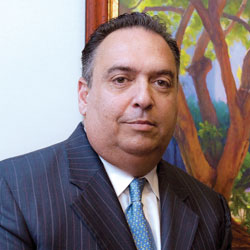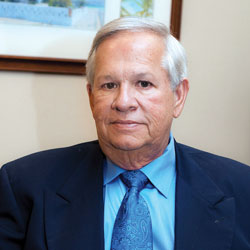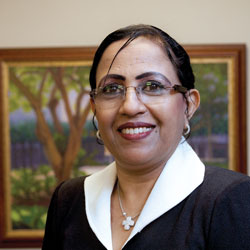It Takes a Community
By Pascal J. Goldschmidt, M.D. | Illustration by Lael Henderson | Photography by Byron Maldonado
Contributions of community physicians enable University of Miami Hospital
to flourish.
This December marks the second anniversary of the purchase of University of Miami Hospital (UMH), the flagship facility of UHealth–University of Miami Health System. We have seen UHealth grow tremendously, reaching patients all over the state of Florida, the United States, and throughout the world.
The three community physicians you are about to meet are part of the outstanding UMH team. In caring for patients at the hospital, they often consult with Miller School faculty physicians or refer patients to them when appropriate. The community doctors—those who were on board before UM bought the hospital and those who have joined since—work tirelessly to provide the very best health care. The three physicians I interviewed reflect the diversity and brilliance of the entire UMH team.
Rafael A. Antun, M.D.
Urologist is Part of a ‘Bright’ Future
 |
| Rafael A. Antun, M.D. |
The city is called San Pedro de Macorism, and it’s famous because most of the great baseball players from the Dominican Republic come from this city. And so does University of Miami Hospital urologist Rafael A. Antun, M.D. He also met his wife, Mayda, in his homeland during medical school. A Cuban-American born in Tampa, Mayda is chief executive officer of Clinica Asociacion Cubana (CAC-Florida Medical Centers). She is an M.D. trained in internal medicine, with a subspecialty in endocrinology. She received her M.B.A. from the University of Miami and is on the advisory board of the University of Miami School of Business Administration.
The Antuns have two children; their 30-year-old son Rafael is a UM-trained lawyer and their 24-year-old daughter Jacqueline attended Florida International University and is now majoring in fashion design
at the Miami International University of Art & Design.
Rafael came to Miami for a residency in urology and was trained by Dr. Victor Politano, then the chair of the department. He always thought that Cedars Hospital should have been a University of Miami facility and is very pleased with its transition from being a Hospital Corporation of America hospital to University of Miami Hospital. He is proud to be part of the team even if he is not a member of the Miller School faculty. He appreciates the leadership of Tony Degina, chief executive officer of UMH, and Mark Soloway, M.D., chair of the Department of Urology. He is quick to point out the great way University physicians and private practice physicians work together and share the hospital.
Rafael believes UMH will be a destination for patients coming from all of Latin America and beyond. His love for learning has led him into the new world of robotic surgery, and he enjoys using the robotic system to perform surgery on patients with urological problems. He believes that the future is bright for both UM faculty and private practitioners at UMH. Dr. Rafael Antun is an outstanding member of our medical community.
Dagoberto Garces, M.D.
Continuing a Surgical Legacy
 |
| Dagoberto Garces, M.D. |
I was delighted to find that Dagoberto Garces, M.D., and I have a common background that played a big role in both of our lives. We were both raised
by fathers who were surgeons.
In fact, Dagoberto’s father owned a hospital in Cuba, which gave Dagoberto tremendous exposure to medicine at an early age. When he was 9, he used to accompany his dad into the operating room.
When Dagoberto and his young friends had cuts and bruises, naturally they went to his father’s hospital, where sulfa powder and dressings were applied to their minor wounds.
That ended in 1962, when Dagoberto was 18. His parents arranged for Dagoberto and two younger brothers to migrate to Miami. From there, the brothers went to Lubbock, Texas, at the urging of a family friend who was a physician.
When talking about Lubbock, Dagoberto remembers: “We didn’t have anything—no money, no jobs, nothing!” He couldn’t even speak English, but got a job as a surgical technician thanks to having done that work with his father.
After attending Texas Tech University, Dagoberto went to medical school in Madrid, Spain. He says the best years of his life were spent in Madrid. The city also happens to be where Dagoberto met Myriam, his wife and the mother of his three children.
After leaving Spain, Dagoberto did an internship at Charity Hospital in New Orleans, followed by four years of general surgery and one of vascular surgery at Mount Sinai Medical Center in Miami Beach.
It goes without saying I’m delighted Dagoberto’s international medical journey ended here at University of Miami Hospital, where he’s a highly skilled and valued vascular and general surgeon. As with so many of our friends who had to leave Cuba, sparkles come to their eyes when they remember their island.
Dagoberto has no regrets about the long road, the challenges, but now with Myriam, their three children, Javier, Ana, and Luis, and a successful career, he says, “It all worked out.”
Jolly Varki, M.D.
A Longtime Respected Oncologist
 |
| Jolly Varki, M.D. |
Jolly Varki, M.D., started treating cancer patients on the University of Miami/Jackson campus before the creation of Sylvester Comprehensive Cancer Center. She has particular expertise in hepatocellular carcinomas and is a well-established and respected oncologist at University of Miami Hospital.
Originally from a small town in India called Kerala on India’s west coast, Jolly attended middle and high school in Bangalore, followed by medical school in the state of Karnataka.
A large percentage of non-native students in U.S. medical schools seems to be from India, an observation Jolly confirms. “First of all, I think it’s because the medium of education is English, which gives Indian students an edge over the rest of the world,” she says.
Jolly adds that Indian parents push their children to pursue engineering or science in college, so students in India begin gravitating toward science-related subject matter as early as elementary school.
Jolly’s introduction to the United States occurred in the 1980s, during a residency in internal medicine at University of Miami/Jackson. That was followed by a hematology/oncology fellowship that allowed Jolly to work with someone she admired greatly, the iconic Dr. William J. Harrington.
During the last year of her fellowship, Jolly was recruited by a small oncology practice affiliated with the former Cedars Medical Center, which is now University of Miami Hospital. The oncology practice has grown to a 49-physician group.
Ask Jolly which facet of her work she enjoys most, and she’ll tell you it’s treating patients in a hospital setting. At Cedars and now UMH, her leadership skills have always been sought; she was instrumental in the successful transition of Cedars to UMH.
Jolly is a married mother whose three children are poised to follow in her footsteps. The eldest is a third-year student at Vanderbilt School of Medicine, the middle child is taking the MCAT exam after earning a B.S. in physics from Boston College, and Jolly’s youngest is a junior psychology major at Tulane University.
Not surprisingly, she’s eyeing medical school!
Jolly’s ability to balance her professional life with her family life is exemplary. She does it with unique grace and intelligence. We are blessed to have Dr. Jolly Varki as a colleague.
|


